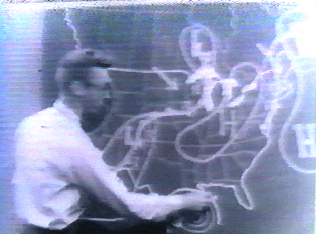|
The worst weather forecast
Charles Hosler ever heard was the inspiration for a
daily televised weather program from Penn State. The
year was 1957 and television was still a curiosity.
Dr. Hosler, a professor in the meteorology
department at Penn State, who had been presenting
weather on radio for ten years, was certainly
curious when he tuned to a local commercial
television station that was starting to broadcast
the weather. What he saw was an announcer reading a
forecast for 24 hours of rain on a day when he knew
that rain was virtually impossible anywhere in
Pennsylvania. The science of meteorology was better
than that, even then! So, Hosler became the driving
force in beginning state-of the-art weather
telecasts to legions of Pennsylvanians.

The
broadcasts came initially from the basement of
Sparks Building on the University Park campus. A
single camera, a stop watch, a chalkboard and a desk
were the studio settings. The weather show was sent
by microwave transmission to WFBG-TV in Altoona. So
popular was Charles Hosler's midday weather report
that area farmers coined the phrase, "you could make
hay with Hosler". In the tradition of a true
educator, Hosler began to give the reigns of his
successful weather broadcast to younger colleagues
and graduate students. One of the first graduate
students to join the weather program was Dick
Hallgren, who went on to become the Director of the
National Weather Service and is the current Director
of the American Meteorological Society. Other
luminaries in the field of meteorology who
participated in the weather segment in a new version
of the show called Farm, Home and Garden, included
Dr. Joel Myers, founder and president of
AccuWeather Inc., one of
the largest and most successful private weather
companies in the nation and Dr. John Cahir, Vice
Provost and Dean of undergraduate education at Penn
State.
In 1965,
when
WPSX, Penn State's
educational VHF television station became a reality,
the weather program continued as a cooperative
effort between the brand new public television
station and the
Department of Meteorology.
As advances in the science became proven, they were
translated into improved forecast information for
Pennsylvania's viewers. The early use of computer
forecasts in the 1960's brought leaps and bounds in
the accuracy of one to two day predictions seen on
Farm, Home and Garden. The first geostationary
weather satellite pictures were broadcast routinely
on a new version of the weather program, State of
the Weather/Shape of the World in 1974. The
personnel changed with new graduate students joining
the on-camera forecasters, but a core of polished
faculty anchored the professional character of the
broadcast.
In 1983, in
none other than Charles Hosler's office, who was
then Dean of the College of Earth and Mineral
Sciences, a new format for the weather show was
born. Instead of a six-minute weathercast at the top
of a thirty-minute public affairs program, a brand
new fifteen minute all-weather program would take
its place. As a broadcast experiment, two
meteorologists were chosen by
WPSX and the
Department of Meteorology
to be producers, hosts and the talent of a new
portion of the show. Weather World premiered on
Labor Day that year as a weather magazine show which
was unique in the world of broadcasting. The
statewide forecast information continued to be the
bedrock of the broadcast, but new longer range
forecasts segments were added. Weather World began
nightly features which demonstrated either how the
weather works or what role the weather plays in
everyday life. Indeed, the feature became the
vehicle for using the weather to introducing viewers
to many topics in the world of science and the
humanities. This element has become a popular
distinguishing characteristic of the program.
Previously
shown on select PBS stations, Weather World began
airing on the
Pennsylvania Cable Network in November
2004. In February 2009, the central
Pennsylvania PBS station,
WPSU, brought Weather
World back to its airwaves.
To take a 360-degree look at our old Weather World
studio or to learn more about our current studio,
visit the Learn More page.
Since its inception in 1957, the
hallmark of the weather presentation from Penn State
has been a respect for the viewers' desire and
ability to understand the world around them. The
daily cooperation between the largest atmospheric
science department in the world and one of the
finest university PBS stations in the country has
helped fulfill the mission of this land grant
institution -- to serve the citizens of the
Commonwealth through the benefits of its research.
|